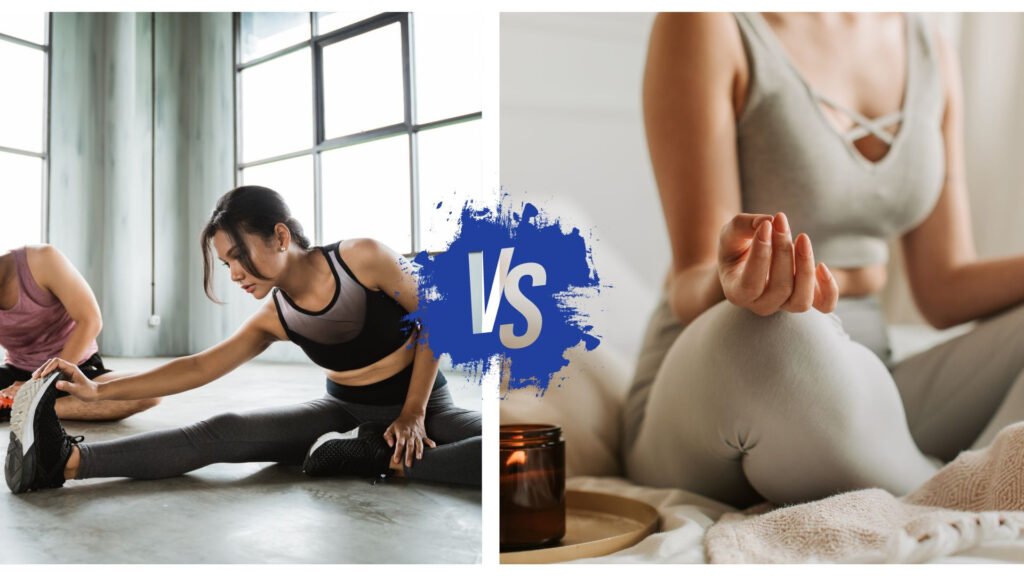Introduction
Stretch therapy and yoga are both popular practices that aim to improve flexibility, mobility, and overall well-being. While they share some similarities, they also have distinct differences in their approaches, techniques, and intended outcomes.

In this blog, we’ll dive into the contrasting aspects of stretch therapy and yoga to help you understand which might better suit your needs and goals.
What is Stretch Therapy?
Stretch therapy, also known as assisted stretching or clinical stretching, is a form of bodywork focused on improving flexibility and range of motion. It involves a therapist or practitioner guiding the patient through a series of passive stretches designed to target specific muscle groups and joints. The stretches are often held for a prolonged period, allowing the muscles to relax and elongate gradually.

One of the primary goals of stretch is to address muscular imbalances and restrictions in movement caused by tightness or stiffness. By targeting these areas with precise stretches, stretch therapy aims to release tension, improve joint mobility, and enhance overall flexibility.
Key features of stretch therapy include:
● Assisted Stretching: Unlike yoga, where individuals perform stretches on their own, stretch therapy involves a therapist applying manual pressure or assistance to deepen the stretch and target specific areas effectively.
● Focus on Individualized Treatment: Stretch therapy sessions are often tailored to the patient’s specific needs and goals. The therapist assesses the patient’s range of motion and identifies areas of tightness or restriction to develop a personalized stretching routine.
● Emphasis on Passive Stretching: While some active engagement may be involved, the primary focus of stretch therapy is on passive stretching, where the patient relaxes while the therapist facilitates the stretch.
● Integration of Bodywork Techniques: In addition to stretching, stretch therapy may incorporate elements of massage, myofascial release, and other bodywork techniques to address soft tissue restrictions and promote relaxation.
What is Yoga?
Yoga is a holistic practice that encompasses physical postures (asanas), breathing exercises (pranayama), meditation, and philosophical teachings. While yoga certainly offers benefits for flexibility and mobility, its scope extends far beyond physical movement to encompass mental and spiritual well-being.

Unlike stretch therapy, which is primarily focused on improving flexibility through targeted stretching techniques, yoga seeks to cultivate harmony and balance in all aspects of life. Yoga classes may vary widely in style, intensity, and focus, but they typically involve a combination of asanas, breathwork, and relaxation techniques.
Key features of yoga include:
● Holistic Approach: Yoga is not just a physical practice; it is a holistic system that addresses the body, mind, and spirit. Alongside improving flexibility and strength, yoga aims to reduce stress, increase mindfulness, and promote overall well-being.
● Self-Practice: While yoga classes led by instructors are common, individuals are also encouraged to develop their own self-practice, allowing them to explore different postures, sequences, and meditation techniques at their own pace.
● Breath Awareness: Integral to the practice of yoga, is the awareness of breath. Pranayama, or breath control exercises, are often incorporated into yoga sessions to calm the mind, increase energy, and enhance the flow of prana (life force) throughout the body.
● Variety of Styles: From vigorous vinyasa flow to gentle restorative yoga, there are numerous styles of yoga to suit different preferences and needs. Each style emphasizes different aspects of the practice, such as strength, flexibility, relaxation, or spiritual growth.
What to Choose Between Stretch Therapy and Yoga?
When deciding between stretch therapy and yoga, it’s essential to consider your goals, preferences, and individual needs. Here are some factors to consider:
Flexibility Goals: If your primary objective is to improve flexibility and address specific muscular imbalances or restrictions, stretch therapy may be more suitable, as it offers targeted, assisted stretching techniques.
Holistic Well-being: If you’re seeking a practice that promotes not only physical flexibility but also mental clarity, emotional balance, and spiritual growth, yoga may be the better choice due to its holistic approach.
Preference for Hands-On Guidance: If you prefer hands-on guidance and personalized attention from a practitioner, stretch therapy offers the benefit of direct assistance in achieving optimal stretching results.
Desire for Variety: If you enjoy exploring a variety of movement styles, breathwork techniques, and philosophical teachings, yoga provides a rich and diverse practice that can be adapted to suit different preferences and moods.
Conclusion
Ultimately, whether you choose stretch therapy or yoga, or even opt to incorporate both elements into your routine will depend on what resonates with you personally and what aligns with your goals for physical and mental well-being!
